National symbols of Bangladesh


| Part of a series on the |
| Culture of Bangladesh |
|---|
 |
| Part of a series on |
| Bengalis |
|---|
 |
The national symbols of Bangladesh consist of symbols to represent Bangladeshi traditions and ideals that reflect the different aspects of the cultural life and history. Bangladesh has several official national symbols including a historic document, a flag, an emblem, an anthem, memorial towers as well as several national heroes. There are also several other symbols including the national animal, bird, flower, instrument and tree.
Flag
[edit]| Flag | Description |
|---|---|

|
The national flag of Bangladesh (বাংলাদেশের জাতীয় পতাকা), known as Red-Green, was officially adopted on 17 January 1972. It consists of a red disc on top of a green field, offset slightly toward the hoist so that it appears centred when the flag is flying. The red disc represents the sun rising over Bengal, and also the blood of those who died for the independence of Bangladesh. The green field stands for the lushness of the land of Bangladesh.[1] The flag is based on a similar flag used during the Bangladesh Liberation War of 1971, which had a yellow map of the country inside the red disc. In 1972 this map was deleted from the flag. One reason given was the difficulty of rendering the map correctly on both sides of the flag. The civil ensign and naval ensign place the national flag in the canton of a red or white field, respectively. |
Emblem
[edit]| Image | Description |
|---|---|

|
The national emblem of Bangladesh (বাংলাদেশের জাতীয় প্রতীক) was adopted shortly after independence in 1971. Located on the emblem is a water lily that is bordered on two sides by rice sheaves. Above the water lilly are four stars and three connected jute leaves. The water lily is the country's national flower and is representative of the many rivers that run through Bangladesh. Rice represents its presence as the staple food of Bangladesh, and for the agriculture of that nation. The four stars represent the four founding principles in the current constitution of Bangladesh of 1972: nationalism, secularism, socialism, and democracy.[2][3] |
Government seal
[edit]| Image | Description |
|---|---|

|
The Government Seal of Bangladesh (বাংলাদেশ সরকার সীলমোহর) is used by the Ministries of Bangladesh[4] and the Government of Bangladesh[5] on official documents. One version is used on the cover page of Bangladesh passports.[6]
The seal features the same design elements as the first flag of Bangladesh in a circular setting. The outer white ring is shown with the caption of the official name of the Government of the People's Republic of Bangladesh in Bengali: গণপ্রজাতন্ত্রী বাংলাদেশ সরকার with 4 red 5-pointed stars. In the centre of the seal is the map of the country on a red disc. |
Musical nationalism
[edit]National anthem
[edit]Amar Sonar Bangla (আমার সোনার বাংলা, "My dear Bengal") is a song written and composed by the Bengali poet Rabindranath Tagore, the first ten lines of which were adopted in 1972 as the national anthem of Bangladesh.[7] The song was written in 1905 during the period of বঙ্গভঙ্গ Bônggôbhônggô (Partition of Bengal (1905)) – when the ruling British empire had the province of Bengal split into two parts. This song, along with a host of others, was written by Tagore, a pioneer of the cultural and political movement against this partition. These songs were meant to rekindle the unified spirit of Bengal, to raise public consciousness against the communal political divide. The lyrics first appeared in the September issues of "Bongodorshon" and "Baul" simultaneously, in 1905. It is said that the music of this song was inspired by the Baul singer Gagan Harkara's song আমি কোথায় পাবো তারে "Ami Kothay Pabo Tare".[8] The instrumental orchestra rendition was composed by Samar Das.[9] The English translation was done by Syed Ali Ahsan.
National march
[edit]Notuner Gaan (Bengali: নতুনের গান, Natunēra gāna) is the national march (Bengali: রণ-সঙ্গীত) of Bangladesh.[10] This song was written by Kazi Nazrul Islam, the national poet of Bangladesh (also known as 'rebel poet'), in 1929. It belongs to his famous book The Evening (Sôndhya: সন্ধ্যা). The music for this song was composed by Kazi Nazrul Islam. On 13 January 1972, the ministry of Bangladesh adopted this song as a national marching song on its first meeting after the country's independence.[10] The first 21 lines of the song are typically played at all military ceremonies or functions in the country; it is also known as the national military song of Bangladesh.[11]
Honour song
[edit]Ekusher Gaan (Bengali: একুশের গান "The Song of Twenty-first"), more popularly known (after its first line) as Amar Bhaier Rokte Rangano (Bengali: আমার ভাইয়ের রক্তে রাঙানো "My Brothers' Blood Spattered"), is a Bengali song written by Abdul Gaffar Choudhury to mark the Bengali language movement in East Pakistan in 1952. It was first published anonymously in the last page of a newspaper with the headline Ekusher Gaan, but was later published in Ekushey's February edition. The song is often recognized as the most influential song of the language movement, reminding numerous Bangladeshis about the conflicts of 1952. Every 21 February, people from all parts of the Bangladesh head to the Shaheed Minar in the probhat feri, a barefoot march to the monument, to pay homage to those killed in the language movement demonstrations by singing this song. It is regarded by listeners of the BBC Bangla radio service as the third best song in Bengali.
Flora and fauna
[edit]| Image | Description |
|---|---|

|
The water lily (Nymphaea nouchali) is the national flower of Bangladesh. Nymphaea nouchali is considered a medicinal plant in Indian Ayurvedic medicine under the name ambal; it was mainly used to treat indigestion.[12] Recent experiments have confirmed that it has medicinal qualities as an antihepatotoxic and antidiabetic.[13][14] Like all waterlilies or lotuses, its tubers and rhizomes can be used as food items; they are eaten usually boiled or roasted. In the case of N. nouchali, its tender leaves and flower peduncles are also valued as food.[15] |

|
The jackfruit (Artocarpus heterophyllus) is the national fruit of Bangladesh. It is native to parts of South and Southeast Asia and widely cultivated in tropical regions of Bangladesh. The jackfruit tree is well suited to tropical lowlands and its fruit is the largest tree-borne fruit,[16] reaching as much as 80 pounds (36 kg) in weight, 36 inches (90 cm) in length, and 20 inches (50 cm) in diameter.[17] |

|
The mango (Mangifera indica) is the national tree of Bangladesh. The mango is native to South Asia, from where it has been distributed worldwide to become one of the most cultivated fruits in the tropics. Its fruit and leaves are ritually used as floral decorations at weddings, public celebrations and religious ceremonies.[18] |

|
The Bengal tiger (Panthera tigris tigris) is the national animal of Bangladesh. Its population has been estimated to be at approximately 440 tigers in Bangladesh.[19][20] Tigers in Bangladesh are now relegated to the forests of the Sundarbans and the Chittagong Hill Tracts.[19] The tiger replaces the lion as king of the beasts in cultures of eastern Asia representing royalty, fearlessness and wrath.[21] Members of the East Bengal Regiment of the Bangladesh Army are nicknameed 'Bengal Tigers'; the regiment's logo is a tiger face and the Bangladesh Cricket Board's logo features a Bengal tiger. |

|
The ilish (Bengali: ইলিশ) or hilsha, also spelled elish (Tenualosa ilisha), is the national fish of Bangladesh. As it is anadromous in nature (an uncommon phenomenon in tropical waters), the ilish lives in the sea for most of its life, but migrates up to 1,200 km inland through rivers in the Indian sub-continent for spawning. Distances of 50–100 km are usually normal in the Bangladeshi rivers. The ilish is a popular fish to eat among the people of South Asia.[22][23] |

|
The Oriental magpie-robin (Copsychus saularis) is the national bird of Bangladesh, where it is common and known as the doyel or doel (Bengali: দোয়েল). They are common birds in urban gardens as well as forests. They are particularly well known for their songs and were once popular as cagebirds. It is a widely used symbol in Bangladesh, appearing on some currency notes; a landmark in the capital city of Dhaka is referred to as the Doyel Chatwar (meaning: Doyel Square). |
National monuments and memorials
[edit]Shaheed Minar
[edit]| Image | Description |
|---|---|

|
The Shaheed Minar (শহীদ মিনার Shôhid Minar lit. "Martyr Monument") is a national monument in Dhaka, Bangladesh, established to commemorate those killed during the Bengali language movement demonstrations of 1952.
The enormous design includes half-circular columns to symbolize the mother, with her fallen sons, standing on the monument's central dais, and the red sun shining behind. The Central Shaheed Minar of Dhaka goes up to a height of 14 metres (46 ft) and was made with marble stones. The stairs and barrier are highlighted in white, to create a divine look. The fence on both sides is painted with lines from poems of legendary poets in iron letters. As visitors enter the monument, they will find two statues of the patriots who sacrificed their lives in the demonstrations. There is also a 1,500-square-foot (140 m2) mural representing the movement’s history.[24] The language movement is one of the most significant movements in the history of Bangladesh. Thus, the Central Shaheed Minar epitomizes efforts to represent the spirit of Bengali nationalism and also highlight the importance of the Bengali language in the social and cultural progress of the country. It has a very significant place in the social and cultural mechanism of Bangladesh; all national, mourning, cultural and other activities held each year on 21 February have been centered around this monument. |
National Martyrs' Memorial
[edit]| Image | Description |
|---|---|

|
The National Martyrs' Memorial (জাতীয় স্মৃতিসৌধ Jatiyô Smrriti Soudhô) is a national monument in Bangladesh. It is dedicated in the memory of the valour and the sacrifice of all those who lost their lives in the 1971 Bangladesh Liberation War, which resulted in the country gaining independence from Pakistan. The monument is located in Savar, about 35 km northwest of the capital, Dhaka.[25] It was designed by Syed Mainul Hossain.
The monument is composed of 7 isosceles triangular pyramid-shaped structures, with the middle one being the tallest. The highest point of the monument is 150 feet. There is an artificial lake, a reflecting pool, a pair of twin bridges, a picturesque garden and several mass graves in front of the main monument. |
Martyred Intellectuals Memorial
[edit]| Image | Description |
|---|---|

|
The Martyred Intellectuals Memorial (বুদ্ধিজীবী স্মৃতিসৌধ) is a memorial built in memory of the martyred intellectuals of the Bangladesh Liberation War. The memorial, located in Rayer Bazaar, Mohammadpur Thana in Dhaka,[26] was designed by architects Farid U Ahmed and Jami Al Shafi.[27][28]
Throughout the Bangladesh Liberation War in 1971, a large number of teachers, doctors, engineers, poets and writers were systematically massacred by the Pakistan Army and their local collaborators, most notably the alleged Islamist militia groups Al-Badr and Al-Shams. The largest number of assassinations took place on 14 December 1971, only two days before the surrender of the Pakistan Army to the joint forces of both the Indian Army and the Mukti Bahini. The initial proposal for a memorial at Rayer Bazaar was brought forward by Projonmo '71 (an organisation of children of martyrs of the Liberation War), which also laid a temporary foundation stone in 1991. |
Independence Monument
[edit]| Image | Description |
|---|---|

|
Swadhinata Stambha (Bengali: স্বাধীনতা স্তম্ভ), or Independence Monument, is a national monument in Dhaka, Bangladesh to commemorate the historical events that took place in the Suhrawardy Udyan, previously known as the Ramna Race Course, in relation to the Bangladesh Liberation War.[29] The Government of Bangladesh took the initiative to build the monument in 1996. Construction began in 1999. Kashef Mahboob Chowdhury and Marina Tabassum designed the project.
Many significant incidents took place in the area now occupied by this monument. On 7 March 1971, Bangabandhu Sheikh Mujibur Rahman delivered his historical speech in the area after Yahya Khan postponed the national assembly on 1 March of that year. In his speech, he asked the people of Bangladesh to prepare themselves for the Liberation War. The main attraction of the monument is a 50-meter high tower, composed of stacked glass panels, that stands at the place where the Pakistani Instrument of Surrender was signed at the end of the Liberation War.[30] |
Other national and official symbols
[edit]| Title | Image | Symbol and notes |
|---|---|---|
| Official name | গণপ্রজাতন্ত্রী বাংলাদেশ Gônôprôjatôntri Bangladesh People's Republic of Bangladesh | |
| State religion |  |
The state religion is Islam (91.04% of the population are Muslim).[31] Equal status and equal rights are granted to the minorities.[32] |
| National poet |  |
কাজী নজরুল ইসলাম Kazi Nôzrul Islam |
| National language |  |
বাংলা Bangla (Bengali) |
| National calendar |  |
বঙ্গাব্দ Bangla saal/Bônggabdô (Bengali calendar) |
| National sport |  |
কাবাডি Kabadi (Ha-Du-Du) |
| National park |  |
ভাওয়াল জাতীয় উদ্যান Bhawal National Park |
| National mosque |  |
বায়তুল মুকাররম Baitul Mukarrôm |
| National temple |  |
ঢাকেশ্বরী জাতীয় মন্দির Dhakeshôri Temple |
| National mountain |  |
কিওক্রাডাং Keokradong |
| National river |  |
যমুনা Jamuna River |
| National museum |  |
বাংলাদেশ জাতীয় যাদুঘর Bangladesh National Museum |
| National library |  |
বাংলাদেশ জাতীয় গ্রন্থাগার National Library of Bangladesh |
| National dish |  |
মাছ ভাত Rice and fish |
| National confectionary |  |
চমচম Chomchom |
| National currency |  |
টাকা Taka |
| National colours | স্বর্ণ সবুজ লাল Red Green Gold | |
| National clothing |  |
Sari (female) Panjabi, Lungi (male) |
| National airline |  |
বিমান বাংলাদেশ এয়ারলাইন্স Biman Bangladesh Airlines |
| National days |  |
Pohela Boishakh (Bengali New Year) International Mother Language Day Independence Day Victory Day |
| National instrument | Dotara |
References
[edit]- ^ "Flag description". The world fact book. CIA USA. Archived from the original on 2017-07-01. Retrieved 2013-09-11.
- ^ A Hossain; G Kabir; M M Ud-deen & A M S Alam (2007). "Cytological studies of Nymphaea species available in Bangladesh". Journal of Bio-Science. 15: 7–13. doi:10.3329/jbs.v15i0.2197. Archived from the original on 2019-04-03. Retrieved 2013-12-11.
- ^ "Constitution" (PDF). Archived from the original (PDF) on 2013-09-22. Retrieved 2013-06-20.
- ^ "বাংলাদেশ (Bangladesh) জাতীয় তথ্য বাতায়ন | গণপ্রজাতন্ত্রী বাংলাদেশ সরকার | People's Republic of Bangladesh". www.bangladesh.gov.bd. Archived from the original on 2018-09-14. Retrieved 2013-12-14.
- ^ "The State". Virtual Bangladesh. Archived from the original on 2013-03-24. Retrieved 2013-05-03.
- ^ "ইমিগ্রেশন ও পাসপোর্ট অধিদপ্তর". www.dip.gov.bd. Archived from the original on 2019-12-31. Retrieved 2021-10-08.
- ^ "Bangladesh: Amar Sonar Bangla". NationalAnthems.me. Archived from the original on 2021-04-11. Retrieved 2011-08-09.
- ^ Folk singer, Swapan Basu Archived 2014-01-05 at the Wayback Machine, demonstrates the similarity in a live recitation (0:43/8:46 to 1:21/8:46)
- ^ Komol, Khalid Hasan (2012). "Das, Samar". In Islam, Sirajul; Jamal, Ahmed A. (eds.). Banglapedia: National Encyclopedia of Bangladesh (Second ed.). Asiatic Society of Bangladesh. Archived from the original on 2016-03-04. Retrieved 2016-01-29.
- ^ a b "India-Bangladesh Joint Celebration, 113th birth anniversary of Poet Kazi Nazrul Islam and 90th year of his poem 'Rebel'". Prime Minister's Office, Government of the People's Republic of Bangladesh. Archived from the original on 2018-12-26. Retrieved 2013-09-23.
- ^ "The rebel poet". The Daily Star. Archived from the original on 2013-09-27. Retrieved 2013-09-23.
- ^ P. V. Sharma, Puṣpāyurvedaḥ – Pradhāna vitaraka Caukhambhā Bhāratī Akādamī, 1998
- ^ MR Bhandarkar; A Khan (2004). "Antihepatotoxic effect of Nymphaea stellata Willd., against carbon tetrachloride-induced hepatic damage in albino rats". Journal of Ethnopharmacology. 91 (1): 61–64. doi:10.1016/j.jep.2003.11.020. PMID 15036469.
- ^ K Rajagopal, K Sasikala -Antidiabetic activity of hydro-ethanolic extracts of Nymphaea Stellata flowers- African Journal of Pharmacy and Pharmacology, 2008
- ^ Irvine, F. R.; Trickett, R. S. (1953). "Waterlilies as Food". Kew Bulletin. 8 (3): 363–370. doi:10.2307/4115519. JSTOR 4115519. Archived from the original on 2021-10-08. Retrieved 2017-09-05.
- ^ "Jackfruit, Breadfruit & Relatives". Know & Enjoy Tropical Fruit. 2012. Archived from the original on 2013-03-22. Retrieved 2012-11-23.
- ^ "JACKFRUIT Fruit Facts". California Rare Fruit Growers, Inc. 1996. Archived from the original on 2014-01-16. Retrieved 2012-11-23.
- ^ "Mango tree, national tree". bdnews24.com. 15 November 2010. Archived from the original on 2013-12-03. Retrieved 2013-11-16.
- ^ a b Khan, M. M. H. (2004). Ecology and conservation of the Bengal tiger in the Sundarbans Mangrove forest of Bangladesh Archived 2019-10-26 at the Wayback Machine. PhD thesis, University of Cambridge.
- ^ Ministry of Environment and Forests. (2004). Report on Sundarbans Tiger Census. Ministry of Environment and Forests, Bangladesh.
- ^ Cooper, J. C. (1992). Symbolic and Mythological Animals. London: Aquarian Press. pp. 226–27. ISBN 1-85538-118-4.
- ^ "Govt likely to review ban on hilsa export | Dhaka Tribune". Dhaka Tribune. Archived from the original on 2016-08-22. Retrieved 2016-08-03.
- ^ Daniyal, Shoaib. "India-Bangladesh relations are so good that Dhaka might even lift its hilsa export ban". Archived from the original on 2016-07-26. Retrieved 2016-08-03.
- ^ Islam, Rafiqul (2000). Amar Ekushey O Shaheed Minar (in Bengali). Dhaka: Poroma. p. 58. ISBN 984-8245-39-1.
- ^ Amin, Md Shahidul; Islam, M Zakiul (2012). "National Martyrs' Memorial". In Islam, Sirajul; Jamal, Ahmed A. (eds.). Banglapedia: National Encyclopedia of Bangladesh (Second ed.). Asiatic Society of Bangladesh. Archived from the original on 2018-09-21. Retrieved 2016-01-29.
- ^ Ahmed, Syed Shabbir (2012). "Mohammadpur Thana (Dhaka Metropolitan)". In Islam, Sirajul; Jamal, Ahmed A. (eds.). Banglapedia: National Encyclopedia of Bangladesh (Second ed.). Asiatic Society of Bangladesh. Archived from the original on 2016-03-04. Retrieved 2016-01-29.
- ^ Amin, Md. Shahidul (2012). "Badhya Bhumi Smriti Soudha". In Islam, Sirajul; Jamal, Ahmed A. (eds.). Banglapedia: National Encyclopedia of Bangladesh (Second ed.). Asiatic Society of Bangladesh. Archived from the original on 2016-02-03. Retrieved 2016-01-29.
- ^ "Icons of History". Star Magazine. Archived from the original on 2018-04-09. Retrieved 2021-10-08.
- ^ সোহরাওয়ার্দী উদ্যান. Dhaka District. 2014-07-18. Archived from the original on 2015-02-01. Retrieved 2015-02-01.
- ^ Syed Sadiqur Rahman (2012), "Ramna Racecourse", in Sirajul Islam and Ahmed A. Jamal (ed.), Banglapedia: National Encyclopedia of Bangladesh (Second ed.), Asiatic Society of Bangladesh, archived from the original on 2016-12-05, retrieved 2017-03-03
- ^ "Bangladeshi Culture – Religion". Cultural Atlas. Archived from the original on 2021-10-06. Retrieved 2021-10-06.
- ^ "Constitution of Bangladesh". Ministry of Law, Justice and Parliamentary Affairs, Government of Bangladesh. Archived from the original on 2019-01-07. Retrieved 2013-11-11.


